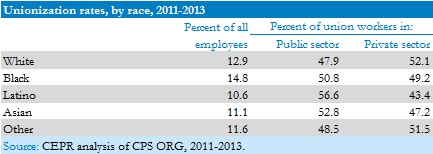May 28, 2014
Since it’s Asian American and Pacific Islander (AAPI) Heritage Month, CEPR decided to take a look at some Census data about AAPI workers. Last week, we talked about low-wage AAPI workers and how an increase in the minimum wage could affect them.
Another interesting story is that of labor unions and AAPI workers. Along with Latinos, AAPIs are the fastest growing sector of the overall workforce as well as unions. The most recent data reveals that 1 in 9 AAPI workers is unionized, which is significantly lower than the rate for whites and blacks, and slightly higher than that of Latino workers.
A majority of AAPI union workers are in the public sector, which is the opposite of the pattern seen with white workers. In fact, AAPI workers have the lowest private sector unionization rate (6.7%) of all the major racial-ethnic groups.

Over the past few years, unionization rates have dropped across the board, continuing the long decline of unions in the U.S. However, one group that showed a slight increase in unionization is AAPI workers with less than a high school education. However, at 9.6%, they’re still less likely to be unionized than AAPI workers with more education.

For more information about AAPI workers, see Unions and Upward Mobility for Asian American and Pacific Islander Workersand Diversity and Change: Asian American and Pacific Islander Workers.






